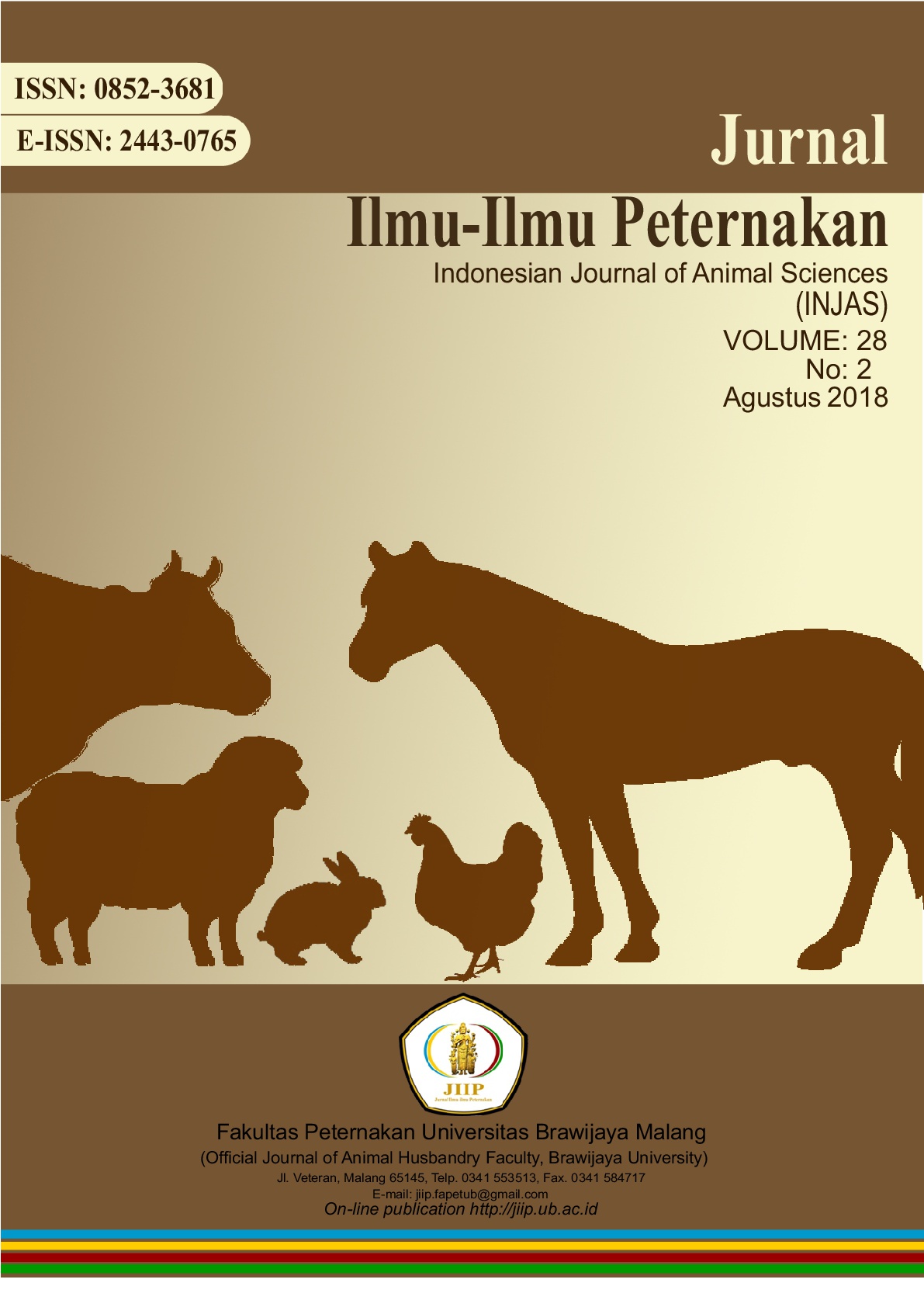Pengaruh pengencer air kelapa tua yang berbeda varietas terhadap kualitas semen cair Kambing Boer pada penyimpanan 3-50C
DOI:
https://doi.org/10.21776/ub.jiip.2018.028.02.03Keywords:
liquid semen, tris aminomethan, cocos rubescens, cocos viridisAbstract
Artificial Insemination using liquid semen is technology reproduction can improve goat productivity without liquid nitrogen. The Purpose of this research was to determine differences of old coconut water varieties of red (Cocos rubescens) and green (Cocos viridis) as diluent Boer goat semen, based on motility, viability and spermabnormalities during storage at 3-50C. The materials used for this research was Boer goat fresh semen as much as 3 heads were collected 2 times a week. Experimental Design. The treatment were devided into three Treatmen, there were: P0 (Tris+ 20% egg yolk); P1 (old coconut water varieties red + 20% egg yolk); P2 (old coconut water varieties green + 20% egg yolk). The data were analyzed by randomized block design, if the result are different or significantly different then continued to be tested with Duncan's multiple range test. The result showed that during storage until days 4, P0 has the best result on motility (40,5 + 1,1 %), viability (45,18+ 1,56 %), and abnormality (1,89+ 0,59 %). While on the diluent using old coconut water green variety better then red variety. On day of 2 P1 and P2 have motility (61 + 1,3%) and (51+ 7,5%); Viability (67,14+17,99%) and (55,37+10,66%), abnormality (1,23 + 1,02%) dan (1,70+ 0,99%).References
Ax, R. L., Dally, M., Didion, B. A., Lenz, R. W., Love, C. C., Varner, D. D., Bellin, M. E. 2016. Semen Evalua-tion. Reproduction in Farm Ani-mals, 363–375. Wiley-Blackwell. https://doi.org/10.1002/9781119265306.ch25
Hafez, E.S.E. 2008. Preservation and Cry-opreservation of Gamet and Em-bryos in Reproduction Farm Ani-mal. E.S.E. Hafez and B. Hafez (eds.) 7th Ed. Lippincott Williams and Wilkins. Marryland. USA, 82-95.
Hayati, R. 2009. Perbandingan Susunan Dan Kandungan Asam Lemak Ke-lapa Muda Dan Kelapa Tua (Cocos Nucifera L.) Dengan Metode Gas Kromatografi. J. Floratek, 4(1), 18-28.
Indriani, T. Susilawati dan S. Wahjun-ingsih. 2013. Daya Hidup Sperma-tozoa Sapi Limosin Yang Dipres-ervasi dengan Metode Water Jack-et dan Free Water Jacket. J. Veter-iner, 14(3), 379-386.
Lestari, T.P.S., M.N. Ihsan dan N. Isnaini. 2014. Pengaruh Waktu Simpan Semen Segar dengan Pengencer Andromed pada Suhu Ruang Ter-hadap Kualitas Semen Kambing Boer. J. Ternak Tropika, 15(1), 43-50.
Ratnawati, D, N. Isnaini dan T. Susilawa-ti.2018. Character Motility of liq-uid semen on Ongole Crossbreed (PO), Bali and Madura Bulls With Different Diluents at Cold Storage. Asian Journal Of Microbiol Env, 20(1), 21-28.
Rizal, M. 2006. Pengaruh Penambahan Laktosa di dalam Pengencer Tris Terhadap Kualitas Semen Cair Domba Garut. J. Pengembang Pet Trop, 31(4), 224-231.
Rizal, M., dan Herdis. 2008. Inseminasi Buatan pada Domba. Jakarta: Rineka Cipta, 32-43.
Susilawati, T. 2013. Pedoman Inseminasi Buatan. Malang: Universitas brawijaya (UB) Press. ISBN: 978-602-203-458-2.
Susilawati, T. 2011. Spermatologi. Ma-lang: Universitas brawijaya (UB) Press.
Susilawati, T., N. Isnaini, A. P, A. Yekti, I, Nurjanah, Errico dan N. D costa. 2017. Keberhasilan Inseminasi Bu-atan menggunakan semen beku dan semen cair pada sapi Peranakan Ongole. Jurnal Ilmu-Ilmu Peter-nakan, 26(3), 14 – 19.
Susilawati, T., D. Ratnawati, N. Isnaini, Kuswati, A P A Yekti. 2018.Character of Liquid Semen Motility in Various Diluents on Balinese Cattle During Cold Stor-age. Asian Jr. Of Microbiol Env, 20(2), 166-172.
Yolanda, H. dan Y. Mulyana. 2011. Uji Coba Penggunaan Limbah Air Ke-lapa Tua sebagai Bahan Dasar Me-dia Isolasi. MKB, 43(3), 117-121.
Yong, J. W., Ge, L., Ng, Y. F., & Tan, S. N. 2009. The Chemical Composi-tion and Biological Properties of Coconut (Cocos nicfera L.) Water. Molecules, 14(12), 5144-5164.
Downloads
Published
How to Cite
Issue
Section
License
Authors who publish with this journal agree to the following terms:- Authors retain copyright and grant the journal right of first publication with the work simultaneously licensed under a Creative Commons Attribution License that allows others to share the work with an acknowledgment of the work's authorship and initial publication in this journal.
- Authors are able to enter into separate, additional contractual arrangements for the non-exclusive distribution of the journal's published version of the work (e.g., post it to an institutional repository or publish it in a book), with an acknowledgment of its initial publication in this journal.
- Authors are permitted and encouraged to post their work online (e.g., in institutional repositories or on their website) prior to and during the submission process, as it can lead to productive exchanges, as well as earlier and greater citation of published work (See The Effect of Open Access).
















